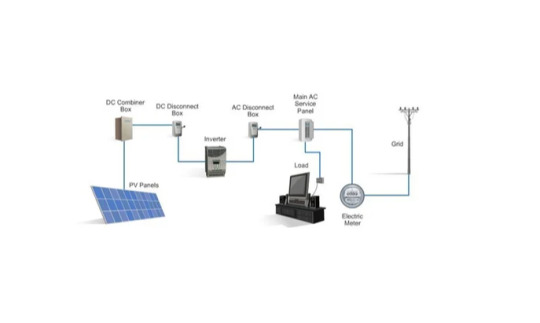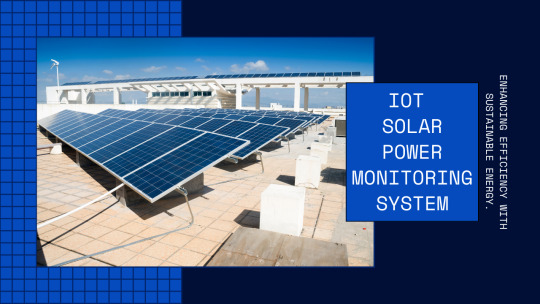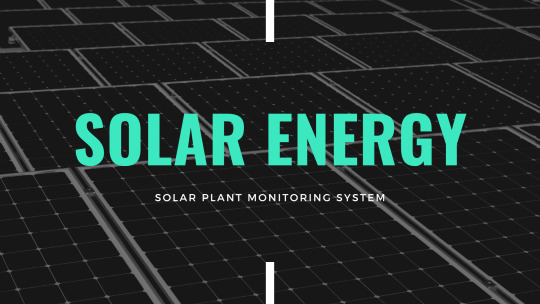#real-time solar power monitoring systems
Explore tagged Tumblr posts
Text
Maximizing Solar Potential: The Advantages of Real-Time Monitoring Systems
The sun’s energy offers a clean and abundant source of power, and India has seen a significant rise in solar energy adoption in recent years. As solar power becomes more integrated into the national grid, optimizing its potential is crucial. This is where real-time monitoring systems come into play, revolutionizing how we manage and maximize solar energy production.
Traditional solar power plants rely on manual inspections and data collection, which can be time-consuming and prone to errors. Real-time monitoring systems, on the other hand, provide a constant stream of data, offering a clear picture of your solar power plant’s performance. These systems, often IoT-based solar power monitoring systems, leverage the power of the Internet of Things (IoT) to collect and transmit data from various sensors installed across the solar panels and inverters.

Here’s how real-time solar power monitoring systems can significantly benefit your solar energy journey:
Enhanced Performance and Efficiency:
Granular Data Analysis: Real-time monitoring provides detailed insights into your system’s performance. You can track power output, voltage, current, and irradiance levels (sunlight intensity) for each panel or string of panels. This granular data allows you to identify underperforming sections and pinpoint potential issues like faulty panels, soiled surfaces, or misaligned trackers.
Proactive Maintenance: By identifying performance dips early on, you can address problems before they escalate into major issues. This proactive approach to maintenance helps prevent costly repairs and downtime, ensuring your solar power plant operates at peak efficiency.
Performance Optimization: Real-time monitoring allows you to compare actual power output with expected output based on historical data and weather forecasts. This enables you to optimize factors like tilt angle and inverter settings to maximize energy production under different weather conditions.
Improved System Reliability and Safety:
Real-Time Fault Detection: Real-time monitoring systems constantly monitor critical parameters like temperature, voltage, and current. This allows for early detection of potential faults or malfunctions within the system, such as overheating or voltage surges. Early intervention can prevent equipment damage and ensure the safety of your solar power plant.
Preventative Maintenance: By identifying potential issues early, you can schedule timely maintenance to address minor problems before they snowball into equipment failures. This preventative approach extends the lifespan of your solar infrastructure and reduces the risk of accidents.
Informed Decision-Making:
Cost Savings: Real-time data empowers you to make informed decisions that can lead to significant cost savings. By identifying and addressing performance issues promptly, you can optimize energy production and minimize grid dependence, potentially reducing electricity bills.
Return on Investment (ROI) Tracking: Monitoring systems allow you to track your plant’s energy production against initial investment costs. This data helps you measure your ROI and assess the financial viability of your solar power plant.
System Expansion Planning: Real-time monitoring data provides valuable insights into your energy consumption patterns. This information can be used to plan future expansions to your solar power plant capacity, ensuring it meets your growing energy needs.
Advanced Features of Real-Time Monitoring Systems:
Modern real-time monitoring systems go beyond basic data collection and offer advanced features that further enhance your solar experience:
Mobile App Accessibility: Many systems offer mobile applications that allow you to access real-time data and system health insights from anywhere. This provides unparalleled convenience and enables you to monitor your solar power plant remotely.
Data Analytics and Reporting: Real-time monitoring systems often come equipped with built-in data analytics tools. These tools can generate comprehensive reports that track performance trends, identify performance bottlenecks, and forecast future energy production.
Alerting Systems: You can configure the system to send alerts via email or SMS for critical events such as sudden performance drops, potential equipment failures, or system downtime. This allows for immediate action to be taken and minimizes potential losses.
Choosing the Right Real-Time Monitoring System:
The Indian market offers a diverse range of IoT solar power monitoring systems. When choosing a system, consider factors such as the size and complexity of your solar power plant, your budget, and the specific features you require. Look for a system that integrates seamlessly with your existing infrastructure and offers reliable data security.
Conclusion:
Real-time monitoring systems are a game-changer for solar power plant management. By providing constant data insights and enabling proactive maintenance, these systems empower you to maximize your solar potential. As India continues to embrace solar energy, real-time monitoring systems will undoubtedly play a vital role in ensuring a clean, efficient, and reliable solar future.
Source: https://ezine-articles.com/maximizing-solar-potential-the-advantages-of-real-time-monitoring-systems/
#iot based solar power monitoring system#iot solar power monitoring system#real-time solar power monitoring systems
0 notes
Text

Trust Logics PowerAMR for your solar monitoring needs. Our IoT-based system ensures accurate, real-time data for informed energy management decisions. Visit: https://poweramr.in/poweramr-solar
#Real-Time IoT Solar Monitoring Systems#IoT based Solar Power Monitoring Systems#Real-Time Solar Power Monitoring Systems#IoT Solar Power Monitoring System
0 notes
Text
Spaceway 70 - Pablo
The Marlin heaves out of the darkened dock, whining with unwarmed engines. A simple objective:
- Assess damages, neutralize threats.
I've done it a million times before. Come to think of it,—
Red lights blare outside and the station's distress call is picked up by the radio. I fly around the cylindrical body—perform a systematic scan. How would the incident report be written?
- Upper hull damaged in a hit-and-run bombing; station status unknown.
- Soldier casualties: ...
Soldiers. They never chose to lay down their lives—to fight for an uncaring ruler—not them.
- Assailant(s): Unknown vessel, presumed solitary. Heat signature detected, actively pursuing.
Ambiguous language. Open to litigation. Sarge would be sad.
- Disregard previous entry. Chasing assailant via engine heat; infrared reading with 0.87 certainty. Monitoring radar.
- Radar confirms a small ship. Moving at 75% of own velocity. Distance 2000 mi.
-
-
- 1500.
-
-
- Approaching civilian zone
-
-
- 1000.
-
-
- 500.
-
- 250.
-
- 175.
-
- 100.
- 50.
- 25.
- Contact.
They pull up and to the left, attempting to get above and behind me, though it's too little, too late.
- Assailant neutralized with ballistics. Assumed to have hit engine.
- Upon visual examination, there appears to have been no pilot. Control is either automated or remote. No outstanding radio frequency detected.
Darn...
Out and ahead of me are markers indicating a commercial route. Safe for traders.
A transponder on one of the markers pings my ship. Something about remaining in place, a unit arriving soon. I don't make it a good hundred miles before a squad comes in with weapons hot.
I dodge a few shots and they graze me with a laser. I'm not about to make war with a whole task force.
The Marlin is a ship of esoteric construction. It has a hull constructed for incredibly heavy salvos—granted you have enough sealant [1] aboard. It comes with a cloak [2], more a scrambler than anything, which uses up insane amounts of power, and an EM pulse [3] which likewise drains my batteries. It's a perfect ship for an early retirement [4], as long as my encounters are few and far between.
With the push of a fader I turn my radio into a tool of war, creating a streak of white along their IR imager and making their radar unusable. Similarly, with a press of a button the magnetron pulses on, disabling their steering and warming up their cabins.
- Three combatants neutralized; nonlethal means
Two more pull down and in front, shooting and missing. I pull up and turn around, hoping to hit them with more microwaves.
< -#- VACDETEC V1.4 -#- >
< ALARM >
<HULL BREACH | d.0s>
<HULL BREACH | d.1s>
<HULL BREACH | d.2s>
I begin to sweat as the laser weapon dissipates as heat into my cockpit.
< HULL SEALED >
< SEALANT AT 25% >
I need to leave.
I reach up to grab a solar compass [5] and scribble my heading onto the cockpit glass.
- Taking extratactical measures: Magnetron shielding angle set to 175.8 degrees
< ## Are you sure? Use of EMP with current settings may cause systems to misbehave. ## >
[ YES ]
Navigation goes dark as two more ships behind me lose steering. I launch a wide-range RF jammer [6] and a hot net [7]. I cut my engines and seal the exhaust [8].
This is a special dance they taught us in Academy; " . . . each ship has its own precise limits, though with them come potential," they had us memorize old literature, "that is why you must know yours more intimately than the body of your lover . . . " I positioned one hand over the exhaust control and another over the ignition. Two seconds, three seconds, and
< -#- SHELL -#- >
< ALARM >
<ENGINE OVERHEAT>
The ship rattles as I rocket dead ahead in the direction of home. Another alarm blares on my monitor,
<CHECK ENGINE>
A few milliseconds too late. I hear a faint whisper—a hiss—join the chorus of the Marlin's song. I'm sorry. I'll fix it soon. It'll be ok.
" . . . for each time you take up the helm, you partake in a romance far more real than any other, for no other can see the terror
of a deprivation so terrible, or a death so swift."
[1]: A chemical formulation which undergoes an extremely exothermic reaction when exposed to the vacuum of space. Akin to tire sealant from when vulcanized rubber was used for land vehicles.
[2]: A system consisting of telescoping antennae and an ultra-high amplitude RF generator. Hides a ship's exact location within a much broader, irregular radio signature.
[3]: A high-powered magnetron capable of producing strong microwaves with multiple miles of range. Temporarily scrambles navigation systems, causing affected ships to veer off-course.
[4]: I can't keep doing this
[5]: An indicator which points in the direction of the closest star, when properly calibrated. Detects the unique products of nuclear fusion.
[6]: Akin to the cloak, a disposable projectile which blanks out vast swathes of a ship's radio imager.
[7]: A large, mechanized retroreflector which concentrates heat from all directions, and shoots it back at the viewer, making infrared imaging of a ship nearly impossible.
[8]: In reference to a mechanism which seals the exhaust vents of the Marlin. This turns the entirety of the engine tract into a bomb. A stupid idea if held closed for more than a few seconds.
39 notes
·
View notes
Text
With a flash, you returned to reality, where the battle had stalled. You saw a bit of battle damage on CONSTANTINE and KUKULKAN- it seems like they sustained a little bit of damage as your interaction with MUSASHI pushed a bit past 'stunning' and turned into a full-on contract. Still, it could be worse.
There was a form standing before you and your Servants. A swordswoman, who smiled amicably.

MUSASHI: "Shinmen Musashi-no-Kami Fujiwara-no-Harunobu, the Flower at the Apex of Heaven, is at your service!"

CONSTANTINE: "A new Servant, and 'Musashi', huh... I guess that means that our Masters were successful. Well, nice to meet you. You may call me 'Rider', we can divulge True Names when we're in… more appropriate company."
PRETENDER: "I get it, I get it. Ah, but a new ally? And a woman claiming to be 'Shinmen Musashi' to boot…"
KUKULKAN: "I'm… uh, Foreigner? Invader? I think there's already a Foreigner, so I'm sticking with Invader! Nice to meet you, Musashi!"

MUSASHI: "Hmm... Rider's pretty handsome, and Invader is cute when she isn't as robot-y... not bad, not bad at all, Masters..."
After listening to MUSASHI murmur something... a bit odd, you realized that you could feel a magical connection between you and her. It seems as if a Contract was established! Monitoring your Command Spells, it seemed as if two of KUKULKAN's Command Spells were transferred over to MUSASHI. It seems like creating multiple contracts without the assistance of some higher power within the system means that you'll have to share. Unless the contract was established before, like with RIDER or potentially AVENGER, and then you'd simply regain the proper amount of Command Spells.
Regardless, of the specifics, this was a success! Because...
[ MUSASHI joined the party! ]

PRETENDER: "Well, as much as I'd love to have a few hours for introductions and teambuilding, there is a Beast currently terrorizing the city, and her main body should now be unimpeded with Miss Musashi's taming."

KUKULKAN: "Oh, right! Draco! Right! Let's go, everyone!"
The rest of the walk was easy. Now with MUSASHI out of the way, at least in terms of her being an active threat against your group, the rest of the path was surprisingly clear. You wandered deeper and deeper into the catacombs, the air growing sticky and dense with vile mana.
You could hear MUSASHI, on instinct, unsheathing her blades and readying them for a battle. You noted that CONSTANTINE had his own hand on the hilt of his blade, but a faint surge of prana restrained his movements as he tried to pull it out, the magic of the Command Spell compelling him against his better instincts.
CONSTANTINE put a hand up, stopping the group.

CONSTANTINE: "We're close. I can sense her- and the terrain is beginning to shift. Which means we'd best strategize on how to handle her."
Your small troupe stopped, looking between one another. This was a conversation that was a long time coming, frankly. CONSTANTINE spoke up first- his voice clear and imperious.

CONSTANTINE: "That Beast is the Whore of Babylon made manifest. The Beast of Revelations as foretold by the apostle Saint John. She is a woman of wicked intent, set on destroying civilization. I understand why that may seem appealing due to our current situation, but all you'll be doing is feeding a monster! Allying with that Beast- becoming a Master of the Beast- will make us the true enemies of the Solar Cell, not just the Lair Servants. Humanity itself will reason for your very destruction. I say we slice her throat as soon as we see the whites of her eyes."
MUSASHI sighed, looking between her new traveling companions.
MUSASHI: "I've fought a lot of real jerks, but my blade hasn't sliced apart any Beasts before. But… I've also known the type of idealist who thinks that they can tame a Beast anyways, so as much as my swords are rattling, I can't lunge one way or the other. I do get what Rider means, though. Sticking the Beast in some other Class may lessen the rest of the World's insistence on killing them, but will make them less… uh, powerful? And that's only if you're able to do it…"
As MUSASHI's comment elicited an eyebrow raise from CONSTANTINE, KUKULKAN spoke up, a bit hesitantly.
KUKULKAN: "I don't know a ton about Beasts and Humanity or the World… I'm still learning about how most aspects of Human History work, but I think we need to take a chance with Draco. I don't want to decide someone is rotten or not just before meeting them, and she'll be good for this fight. I'm sure there's some good there too! If everyone hates us for the choices we make, that's okay, right? We'll be a team! You decided that you'd be enemies of this world for the sake of saving it."
The discussion was cut short as a voice pierced through the air--
???: "Stop sitting and chittering in the wings like rats, and fully reveal yourselves on my stage. To hold up a performance is poor manners, you know?"

As your Servants hesitantly reached the amphitheater, the sky seemed to be blotted out by the dark shape that moved, slowly and intentionally. You felt eyes boring down on you, a presence and weight that held a unique sense of 'gravity'.
Looking up, you saw the massive shadow of ALTER-EGO… or at least a Servant that greatly resembled her. Her body was clad head to toe in black leather, her eyes having lost their joy and luster in exchange for a bitter darkness. An innocent being, once calmed by the melody of 'Twinkle, Twinkle, Little Star', now twisted into something devoid of that purity.

DRACO: "Welcome, o' Former Masters of mine, to my great stage! Oh, and do not mind my new toy. My mud has corroded her mind, Altered her Spirit Origin, and to be surrounded by a woman as beautiful as the sakura trees of the East is only an apt beginning of an imperial court. She is one of my Seven Heads made manifest, now. I've taken to calling her 'Sakura Superbia'."

KUKULKAN: "Wow... Draco is a pretty fast worker, isn't she...? Even I can tell that Servant is super dangerous, luckily, I'm sure our Masters are already thinking of a top-rate contingency plan if things go south... right?"
Staring up with an inscrutable expression, PRETENDER tutted.

PRETENDER: "Alter-Ego... You're quite the problematic Servant, aren't you? Always landing in some inconvenient situation. Avenger and Foreigner will be very upset if we don't fix this..."

"SAKURA SUPERBIA": "Pretender, Pretender, Pretender... you were always tiny like an insect, but now I feel like I could pin you and those pretty little wings to a board. Or should I just squish you instead?"

CONSTANTINE: "How lovely. So... that settles what happened to Alter-Ego, but what of Assassin?" MUSASHI: "You don't think they're controlled like that big girl?"
With a shake of his head, CONSTANTINE continued to look around the area.
CONSTANTINE: "Maybe, but... I'd like to be optimistic and say they escaped..."
Looking down below ALTER-EGO, in the shadow of the Massive Servant, you saw DRACO. She didn't seem... weak, particularly, but she had seemed stronger. It seemed like the lack of a proper contract was putting some toll on her body.

DRACO: "The sword is still in your possession, yes? Good. Deliver my sword, and I shall grant you wisdom of the Solar Cell. Give me tribute, and I shall consider renewing our contract. But behold, with my assistance, you gain an even mightier ally. How magnanimous am I. Normally I would have you kneel, but as you have no true body, my former Masters, I cannot ask you to bow your heads and beg for forgiveness. However, the Rider…"
You saw her mouth twist into a bitter, amused grin. CONSTANTINE shuddered though he did not look away, his eyes cold and piercing.

CONSTANTINE: "Oh, please speak, Whore of Babylon. Give me ample cause to wrench myself free of the Command Spell's curse and loose your head from your vile shoulders."
This seemed like an expected outcome. You told him he couldn't act out and defy your instructions- which at this point cycled around 'wait and see' regarding DRACO. That didn't mean he had to be nice about it.

DRACO: "How brave. Then yes, if you make him beg instead, that will be a far more amusing sight. And have him lop off his own head as well, then I will consider that apt sacrifice and have your debts repaid in full. After all, he disrespected my imperium, and dared to draw his blade against me. Such a rabid dog cannot be allowed to live, lest he bite the hand that feeds."

DRACO: "However, I am nothing but not fair. I'll give you time to discuss. I hope you make the right decision. After all, any resistance, and I'll bring down the might of 'Sakura Superbia' on you."
It seemed as if you were far enough away at the moment to discuss without being eavesdropped on, though close enough that you could call and speak to DRACO via the 'Endless Whispers' code cast regardless.
26 notes
·
View notes
Text

Research projects protect national security assets from space weather
Space weather is a double-edged sword: It's capable of delivering majestic phenomena like the auroras near Earth's poles, but it can also have more alarming consequences with significant national security implications.
In 2014, for example, researchers at the Johns Hopkins Applied Physics Laboratory (APL) in Laurel, Maryland, discovered that plasma bubbles connected to space weather partly contributed to communications outages during a major battle in the Afghanistan War, during which three Navy SEALs died.
APL researchers continue to work on applications such as atmospheric models and new sensors and instruments not only to aid in discovering anomalies caused by space weather but also to investigate how to keep critical national security assets safe both in space and on the ground.
"Society has such a dependence on space now," said Ben Estacio, an APL researcher who supervises a team that investigates how space systems can work within the space environment. "Most people don't realize how much of their daily lives rely on space."
The sun's Influence
A powerful solar flare or a coronal mass ejection—events where plasma bursts away from the sun into space and possibly toward Earth—can potentially disrupt power grids, affect railroads or harm astronauts operating in space.
But space weather events can also affect national security in various ways, such as disrupting GPS, radio and satellite communications; affecting radar performance and capabilities; and creating drag on satellites, knocking them off course.
For example, in radio communications, space weather can cause ionospheric scintillation, a phenomenon during which subtle changes in the ionosphere alter how radio waves travel. In some scenarios, radio signals sent at the appropriate frequency typically bounce off the ionosphere. When space weather events occur, those signals can bounce in unexpected directions or escape through the ionosphere.
"If you're broadcasting on the ground through a disturbed ionosphere, other spacecraft may receive radio signals you're trying to send securely," said Bob Schaefer, an APL space physicist.
Space weather events can also lead to a loss of assets and could leave national security capabilities vulnerable. "Strong space weather events can adversely affect one system or a combination of systems," said Pat Dandenault, a physicist specializing in space weather research at APL.
"When that happens, other people can take advantage of critical systems and networks. The ability to forecast these dynamics and the potential impacts of space weather phenomena in near-real time is critical."
Assessing space weather's impact
APL experts have developed a myriad of research areas and applications aimed at helping the Laboratory's sponsors better understand how space weather impacts the nation's assets.
Initiated in 2020, the NASA Center for Geospace Storms (CGS) is developing a holistic, predictive space weather simulation that will estimate how space weather events impact Earth. In April, CGS made this model available for simulations upon request through NASA's Community Coordinated Modeling Center (CCMC).
"The availability of these simulations at CCMC marks a significant step forward, empowering the scientific community to work together toward deepening our understanding of how space weather affects the near-Earth environment," said APL's Slava Merkin, director of CGS.
Multiple APL efforts aim to measure and model space physics properties to specify and forecast ionospheric behavior, uncovering when disruptions in the upper atmosphere might happen and monitoring changes in atmospheric satellite drag conditions caused by space weather. These include:
Special Sensor Ultraviolet Spectrographic Imager (SSUSI): A series of APL-built instruments that power more than 20 space-weather-related products in near real-time for the U.S. Space Force to help describe the state of the ionosphere, thermosphere and auroral zone environments
Next-generation Ionosphere Model for Operations (NIMO): A predictive, assimilative model of the ionosphere that can use data from ground GPS receivers, radio occultation from satellites, ionosondes and SSUSI data
OVATION Prime: A predictive model of auroral location, boundaries and energy flux used operationally by the Space Force and NOAA's Space Weather Prediction Center
High-Latitude Ionosphere Specification: An ensemble of models that have been combined with data assimilation capabilities to generate detailed, near-real-time ionosphere specifications for use in multiple Department of Defense applications, such as radar systems in the high northern latitudes
Having these resources is especially beneficial to national security sponsors as they troubleshoot and mitigate problems that may impact critical assets, Estacio said. "Understanding if something was done to your spacecraft intentionally or was just the result of natural high-energy particles is a crucial distinction to be able to make."
4 notes
·
View notes
Text
palisade 22:
it feels like we’re back in partizan.
specifically, in the final arc and finale. inevitability, monochrome, horrific threats and risky plays. a mission underground. a space infiltration. divines scouring the void. (are we back, or did we never leave?)
the new theme music reminds me so much of the partizan finale theme.
the constantly changing gravity inside chimera’s lantern—do we carry it with us?
and then there’s “once the war’s over”.
what i’ve been thinking is, you know, the blue channel has all the narrative power against the stargrave because the stakes are so high that they can justify any sacrifice, which could grant them mechanical power because armor astir facilitates that. and… here we are.
but man am i gonna miss phrygian.
anyway, it adds to the partizan feeling: knowing that someone is going to die, tasting the dream of a happier ending but plunging back into the fight…
(i’ve definitely brought this up before but i am always ALWAYS thinking about the blue channel going back for the pzn finale.)
in other news:
excited for the title drop mostly because it feels like a real arc title—i can think of a dozen relevant ideals that might be proven impossible (/achieved anyway?), in either plot.
my hopes for spaceship bottle horror were so high and this ep did not disappoint. shutting down the systems and gliding silently is excellent sf, as is the heat shields going out. now someone can go out there in a spacesuit and try to fix them >:)
also want to shout out phrygian’s crt monitor & longhand math approach
paramerion is FANTASTIC. love to simply become a sword. love to become a sword specifically to take down your rival in the visage of a dead saint.
pleased to be beyond clocks at this stage. the clock has already ticked; it’s midnight.
mustard red’s offer… very scary. very interesting. love that the players are being offered the option of getting even more out of this—raising the positive stakes on their side.
hearing each planet in the mirage included in the intro was heartwrenching. also “most people don’t have time to practice dying”/“but that doesn’t mean they aren’t afraid, on palisade”
i bet it was a really weird day for the rose river sleep detachment when they found out about the solar system, maine
really fascinating to listen to this while in the middle of aih 20. weird dungeons! half-understood histories!
it is always an interesting process to write topical fanfiction for a weekly show. (fic. features a take on this mission that nowhere near happened, which i expected, but also you can probably tell where i was hedging my bets re phrygian—i very nearly went this sort of route, where someone would have to die.)
welcome to the end of this world, or, yknow, the fatt midseason finale.
#fatt#palisade#hello world#fatt lb#palisade spoilers#friends at the table spoilers#crossing my fingers so hard that this is a 5 ep arc so i’m not in the fckn woods when they either do or do not blow it up#anyway. very exciting :)
30 notes
·
View notes
Text
Future of Power Transformer Market: Innovations and Developments
The global power transformer market was valued at USD 22.83 billion in 2022 and is anticipated to expand at a compound annual growth rate (CAGR) of 7.1% from 2023 to 2030. This growth is primarily driven by the increasing demand for electricity in both emerging and developed countries, coupled with significant investments in infrastructure. As urbanization and industrialization continue to accelerate, the need for reliable and efficient power distribution systems is expected to fuel market growth. Additionally, the rising focus on modernizing the existing energy grid systems and improving energy efficiency will be key factors driving the demand for power transformers over the forecast period.
A major contributing factor to the market's expansion is the growing adoption of smart grid technology. The development of smart grids, which incorporate advanced technologies like smart meters and automated control systems, is creating a significant demand for more sophisticated power transformers. Smart meters, in particular, are integral to the efficient functioning of smart grids as they enable real-time monitoring and management of energy consumption. The widespread push for smart grid development, along with government initiatives to modernize power infrastructure, is expected to have a positive impact on the power transformer market over the next several years.
In addition to smart grids, the power transformer market will be further supported by the rising focus on renewable energy sources and the increasing need to develop transmission networks for remote and off-grid locations. The integration of non-traditional energy sources, such as wind, solar, and hydropower, into the power grid requires efficient power transformers that can manage variable power outputs and ensure reliable electricity distribution.
Gather more insights about the market drivers, restrains and growth of the Power Transformer Market
Phase Insights
The power transformer market can be segmented based on phase type into two categories: single-phase and three-phase transformers. As of 2022, the three-phase transformer segment accounted for the largest share of the market, with a dominant market share of 62.2%. This segment is expected to grow at the fastest rate, with a projected CAGR of 7.2% by 2030.
Three-phase transformers are widely used in various industrial applications due to their high efficiency and ability to handle large power loads. They are commonly used in industries such as manufacturing, mining, petrochemicals, automation, and telecommunications, among others, for both power generation and distribution. These transformers are especially suited for industrial settings because they are more affordable, compact, and lightweight compared to other transformer types, especially when dealing with high power ratings.
In addition to being cost-effective, three-phase transformers offer several operational advantages. They are ideal for low-voltage distribution systems that experience high fluctuations in voltage. Their design allows for superior isolation, common-mode interference suppression, and they can be customized to meet specific end-user requirements. Furthermore, they are particularly effective in environments that require a stable and continuous power supply, making them indispensable for a wide range of applications, including precision machinery and automated systems.
Given their many advantages and the growing number of industries relying on them, three-phase transformers are expected to continue dominating the market and experience robust growth during the forecast period. Their versatile applications and increased adoption across multiple industrial sectors further underline their critical role in the development of power distribution systems worldwide.
Order a free sample PDF of the Power Transformer Market Intelligence Study, published by Grand View Research.
#Power Transformer Market#Power Transformer Market Analysis#Power Transformer Market Report#Power Transformer Industry
2 notes
·
View notes
Text
Top 10 Projects for BE Electrical Engineering Students
Embarking on a Bachelor of Engineering (BE) in Electrical Engineering opens up a world of innovation and creativity. One of the best ways to apply theoretical knowledge is through practical projects that not only enhance your skills but also boost your resume. Here are the top 10 projects for BE Electrical Engineering students, designed to challenge you and showcase your talents.
1. Smart Home Automation System
Overview: Develop a system that allows users to control home appliances remotely using a smartphone app or voice commands.
Key Components:
Microcontroller (Arduino or Raspberry Pi)
Wi-Fi or Bluetooth module
Sensors (temperature, motion, light)
Learning Outcome: Understand IoT concepts and the integration of hardware and software.
2. Solar Power Generation System
Overview: Create a solar panel system that converts sunlight into electricity, suitable for powering small devices or homes.
Key Components:
Solar panels
Charge controller
Inverter
Battery storage
Learning Outcome: Gain insights into renewable energy sources and energy conversion.
3. Automated Irrigation System
Overview: Design a system that automates the watering of plants based on soil moisture levels.
Key Components:
Soil moisture sensor
Water pump
Microcontroller
Relay module
Learning Outcome: Learn about sensor integration and automation in agriculture.
4. Electric Vehicle Charging Station
Overview: Build a prototype for an electric vehicle (EV) charging station that monitors and controls charging processes.
Key Components:
Power electronics (rectifier, inverter)
Microcontroller
LCD display
Safety features (fuses, circuit breakers)
Learning Outcome: Explore the fundamentals of electric vehicles and charging technologies.
5. Gesture-Controlled Robot
Overview: Develop a robot that can be controlled using hand gestures via sensors or cameras.
Key Components:
Microcontroller (Arduino)
Motors and wheels
Ultrasonic or infrared sensors
Gesture recognition module
Learning Outcome: Understand robotics, programming, and sensor technologies.
6. Power Factor Correction System
Overview: Create a system that improves the power factor in electrical circuits to enhance efficiency.
Key Components:
Capacitors
Microcontroller
Current and voltage sensors
Relay for switching
Learning Outcome: Learn about power quality and its importance in electrical systems.
7. Wireless Power Transmission
Overview: Experiment with transmitting power wirelessly over short distances.
Key Components:
Resonant inductive coupling setup
Power source
Load (LED, small motor)
Learning Outcome: Explore concepts of electromagnetic fields and energy transfer.
8. Voice-Controlled Home Assistant
Overview: Build a home assistant that can respond to voice commands to control devices or provide information.
Key Components:
Microcontroller (Raspberry Pi preferred)
Voice recognition module
Wi-Fi module
Connected devices (lights, speakers)
Learning Outcome: Gain experience in natural language processing and AI integration.
9. Traffic Light Control System Using Microcontroller
Overview: Design a smart traffic light system that optimizes traffic flow based on real-time data.
Key Components:
Microcontroller (Arduino)
LED lights
Sensors (for vehicle detection)
Timer module
Learning Outcome: Understand traffic management systems and embedded programming.
10. Data Acquisition System
Overview: Develop a system that collects and analyzes data from various sensors (temperature, humidity, etc.).
Key Components:
Microcontroller (Arduino or Raspberry Pi)
Multiple sensors
Data logging software
Display (LCD or web interface)
Learning Outcome: Learn about data collection, processing, and analysis.
Conclusion
Engaging in these projects not only enhances your practical skills but also reinforces your theoretical knowledge. Whether you aim to develop sustainable technologies, innovate in robotics, or contribute to smart cities, these projects can serve as stepping stones in your journey as an electrical engineer. Choose a project that aligns with your interests, and don’t hesitate to seek guidance from your professors and peers. Happy engineering!
2 notes
·
View notes
Text
China Radar Uncovers Plasma Bubbles Over Pyramids: Implications for Satellite Safety

Chinese scientists have made a groundbreaking discovery with their newly developed radar system, detecting unusual plasma bubbles over the Egyptian pyramids and Midway Islands. This radar, known as the Low Latitude Long Range Ionospheric Radar (LARID), was inaugurated by the Chinese Academy of Sciences last year and has since revealed a significant phenomenon that could impact satellite communications and GPS systems.

Plasma bubbles—large-scale disruptions in the ionosphere caused by solar activity—were notably observed following a solar storm in November. According to a recent announcement by Chinese researchers on August 27, this detection marks the largest recorded observation of such bubbles, with radar signals extending from North Africa to the Pacific Ocean. The discovery, reported by the South China Morning Post, provides valuable insights into the behavior and distribution of these ionospheric anomalies.
Overview of the LARID System
Positioned on Hainan Island, LARID is capable of detecting plasma bubbles up to 9,600 kilometers away, covering a vast expanse from Hawaii to Libya. Unlike conventional radar systems, LARID employs powerful electromagnetic waves that traverse between the Earth’s surface and the ionosphere, allowing it to monitor phenomena beyond the conventional horizon. Equipped with 48 antennas, LARID features real-time adjustment capabilities and has seen its operational range extended from an initial 3,000 kilometers to 9,600 kilometers due to technological enhancements.
The radar’s ability to detect plasma bubbles is crucial, given their potential to interfere with satellite communications and GPS systems. In response to this, Chinese scientists are advocating for a global network of similar radars in low-latitude regions to enhance worldwide detection capabilities.
Strategic and Technological Repercussions
Beyond its scientific applications, LARID’s advanced radar technology has implications for military and defense strategies. The system’s capability to detect objects such as stealth aircraft suggests that even more sophisticated radar versions may be under development, potentially bolstering China’s defense infrastructure.
This development underscores the growing importance of radar technology in both scientific research and military applications, highlighting a need for increased vigilance in monitoring and mitigating disruptions in space-based communications.
2 notes
·
View notes
Text
Unlocking the Potential of Solar Energy: The Role of Solar Management Dashboards

In the era of sustainable energy, solar power has emerged as a pivotal solution for reducing carbon footprints and harnessing renewable resources. As solar energy systems become more prevalent, effective management and optimization are essential to maximizing their benefits. This is where solar management dashboards come into play. These powerful tools offer comprehensive insights and control over solar energy systems, making them indispensable for both residential and commercial solar installations. In this article, we explore the significance of solar management dashboards, the role of solar management dashboard development, and the impact of solar management dashboard development services on the solar industry.
Understanding Solar Management Dashboards
A solar management dashboard is a centralized platform that provides real-time monitoring, analysis, and control of solar energy systems. These dashboards aggregate data from various components of a solar power system, including solar panels, inverters, batteries, and energy meters, to deliver actionable insights and streamline system management.
Key Features of Solar Management Dashboards:
Real-Time Monitoring: Dashboards offer live updates on the performance of solar panels, including energy production, system efficiency, and operational status. This allows users to track performance and detect issues promptly.
Performance Analytics: Advanced analytics tools within the dashboard provide insights into energy production trends, efficiency metrics, and system health. These insights help in optimizing performance and identifying areas for improvement.
Alerts and Notifications: Automated alerts notify users of potential issues such as equipment malfunctions, performance drops, or maintenance needs. This proactive approach helps in addressing problems before they escalate.
Energy Management: Dashboards facilitate the management of energy consumption and storage. Users can monitor energy usage patterns, track battery levels, and make informed decisions about energy distribution and consumption.
Reporting and Visualization: Customizable reports and visualizations help users understand system performance over time. Historical data analysis and graphical representations make it easier to assess the impact of solar energy on overall energy costs and savings.
The Importance of Solar Management Dashboard Development
The development of a solar management dashboard involves creating a user-friendly and feature-rich interface that effectively integrates with solar power systems. This development process is critical for ensuring that dashboards meet the specific needs of users and provide accurate, actionable data.
Key Aspects of Solar Management Dashboard Development:
Integration Capabilities: A well-developed dashboard must seamlessly integrate with various solar components and technologies. This includes compatibility with different types of solar panels, inverters, and energy storage systems.
User Experience (UX) Design: The dashboard should be designed with user experience in mind, offering an intuitive interface that simplifies navigation and data interpretation. A good UX design ensures that users can easily access and understand the information they need.
Data Accuracy and Security: Accurate data collection and transmission are crucial for reliable performance monitoring. Additionally, robust security measures must be implemented to protect sensitive data from unauthorized access or breaches.
Customization and Scalability: The dashboard should be customizable to fit different user requirements and scalable to accommodate future upgrades or expansions of the solar power system.
The Role of Solar Management Dashboard Development Services
Solar management dashboard development services play a crucial role in bringing these dashboards from concept to reality. These services offer specialized expertise in designing, developing, and deploying solar management solutions that cater to the unique needs of each solar energy system.
Key Benefits of Solar Management Dashboard Development Services:
Tailored Solutions: Development services provide customized dashboard solutions that align with the specific requirements of a solar power system, ensuring that the dashboard effectively meets the user's needs.
Expertise and Innovation: Leveraging the expertise of experienced developers and industry professionals, these services bring innovative features and technologies to the dashboard, enhancing its functionality and performance.
End-to-End Support: Development services offer comprehensive support throughout the entire process, from initial consultation and design to implementation and ongoing maintenance. This ensures that the dashboard remains functional and up-to-date.
Optimized Performance: By utilizing advanced development techniques and best practices, these services ensure that the dashboard delivers optimal performance, accuracy, and reliability in monitoring and managing solar energy systems.
Future Trends in Solar Management Dashboards
As technology continues to advance, the future of solar management dashboards holds exciting possibilities:
Enhanced AI and Machine Learning: Future dashboards will increasingly incorporate AI and machine learning algorithms to provide predictive analytics, automated adjustments, and advanced troubleshooting capabilities.
Integration with Smart Grids: The integration of solar management dashboards with smart grid technologies will enable more efficient energy distribution and enhance grid stability.
Advanced Data Visualization: Improved data visualization tools will offer more detailed and interactive representations of solar energy performance, making it easier for users to analyze and act on data.
User-Centric Innovations: Ongoing developments will focus on enhancing user experience, with features such as voice commands, mobile access, and personalized dashboards tailored to individual preferences.
Conclusion
Solar management dashboards are essential tools for optimizing the performance and efficiency of solar energy systems. With the growing importance of solar power in our quest for sustainability, the role of solar management dashboard development and solar management dashboard development services becomes increasingly critical. These dashboards not only provide valuable insights and control over solar power systems but also contribute to the overall success and effectiveness of renewable energy initiatives. As technology continues to evolve, embracing advanced dashboard solutions and development services will help maximize the potential of solar energy and drive us towards a more sustainable future.
2 notes
·
View notes
Note
This might come off as “broad” but I guess government organizations in your world? I know I've read about a couple of them. Just the roles, how they came to be, who runs them etc
I don't keep firm holds on my governmental organizations unless they're relevant, mostly because that's a lotta politics and a lot of the characters I focus on tend to lie on the outskirts or are antagonists of the government (gee, I wonder why).
So I've mentioned these guys before but; the United Federation of Solar Systems (UFSS) is the big one.

They're run by the uber-powerful uber-sensitive Minders, a collection of like, 100 or so beings. The Federation is essentially the governing body that says "Okay, let's shake hands and stop bullying the other kids on the playground please." in that their two primary goals are:
Preventing interstellar war
Preventing exploitation of lesser advanced civilizations.
In this, they mostly monitor and restrict military buildup and contact with other civilizations, as well as set up residential areas on dead planets. One of it's big quirks is that it's actually really easy to apply for a general UFSS citizenship, and there's a big reason for that. See, at some point, individuals started to be able to make machines that were indistinguishable from real people. If these robots turned out to be fully sentient, capable of pain and scarring, then letting that aspect go unchecked could end up as slavery 2 electric boogaloo, and the Federation didn't want that under their jurisdiction. So they took the easy solution out, and made the ability to apply for a citizenship essentially the act of filling out a moderately long form and arranging for someone to take your picture. That's it. If your roomba's smart enough to apply for its own citizenship, then it's a citizen. We're not arguing over this. It's a citizen and you'll treat it like one. Like all systems, it isn't perfect, and companies keep trying to circumvent this solution so they can have Good Cheap Labor, but it's there and it's got that unique quirk where anyone, part of the Federation, made by someone in the Federation, not part of the Federation, anyone who can apply can become a citizen.
The Federation handles its second issue of preventing colonization of inhabited planets by essentially forcing all economic interactions to be some form of trade. You can't build a mine on a planet not part of the UFSS, even if the other planet's governments are fine with it, but they can and trade the profits with you. There's quite a lot of legal finagling in this aspect, such as minimum exchange rates, what counts as a UFSS entity owning part of another planet, individuals vs corporation interactions, what you can and cannot exchange, how many UFSS people can live on the planet's surface, the nightmare of tourism, etc etc.
Notably, while the Federation bans interstellar colonization, it doesn't ban war between individual Federation entities and non-Federation entities. This is because one of it's oldest members, Crystal Dragons, have been constantly fighting Titatiaraum and his numerous attempts to exterminate their entire race. War in this manner is still heavily restricted: the enemy must be able to demonstrate on some level they are both trying and capable of attacking you and you must minimize damage done to them. It doesn't go well in Titatiaraum's case, the Crystal Dragons end up overstepping their bounds and completely wiping out Titatiaraum's realm and his angels. The choice was contested for a long time, namely because they left the Paragons, the "civilians" alone, and only targeted their angels and gods, which generally play under different rules as they are divine. Eventually the Crystal Dragons would be forced to pay reparations as Titatiaraum's destruction lead to the collapse of the Paragon's home planet and would have doomed them, and eventually the Crystal Dragons left the UFSS.
Working for the Federation is not fun, it's 96% management/enforcement jobs, usually on cold dead planets, dealing with someone else's law firm as to why dumping waste in the asteroid belt of some star isn't legal because they'll mess up the weight balance in that system and cause asteroid strikes on the inhabited planet on that system. It's that kind of thing.
As for others I'll speedrun them as they aren't as detailed:
Threaders have an oligarchy of the most powerful Loomers, and they live in a castle on SS's dead body.
Mins are usually governed by Meds and maybe some Mins, but in the case of L-Mins, it's generally a lot more nebulous and sometimes pretty lawless.
Ourul congregations don't have any overarching structure, instead they have an appointed "interpreter" that dictates the rules on Malxivos's (Mal-skiv-ous) texts, but an interpreter's main job is to check on other congregations and see if they're breaking the code.
Northern Ermista towns are usually run communally by everyone in it.
Ermista Shadow Arcana roles are handed out by this bigass school/university/what-have-you with the council of their oldest members.
Amalgamate Arcana is run by an appointed few who basically manage rotations of their god (who's allow to call them and when). There's other roles and they're all appointed.
The Tank Dragons are an extension of their species's military, and mostly play under military-esc laws.
Cosmolians have a monarchy, their monarchy is also subject to a disease that makes them bleed out every orifice until they die.
Light Dragons/Shadow Dragons are actually run by their gods, which isn't actually all that common. You'd think.
OH. There was this one asshole, Altarion, who was a Spirit in a Min's body, who killed a city's Med and essentially turned it into a theocracy of worshiping him. Kinda funny actually.
The mining ships have a council/council building for their government. Pyro was kicked out of that council for repeatedly bitching about having to "sucker up to the UFSS's rules and their crooked cohorts" and mild conspiracy theories about the UFSS feeling guilty about mismanaging the whole situation.
3 notes
·
View notes
Text
The Role of Energy Management Systems in India's Growth
India is a nation on the rise. Its booming economy and ever-growing population are driving a surge in energy demand. To meet this demand while ensuring sustainability and economic viability, India is focusing on efficient energy management. This is where energy management systems (EMS) come into play, acting as a powerful tool for propelling India's growth trajectory.
What are Energy Management Systems (EMS)?
An energy management system (EMS) is a software-based solution that tracks, analyses, and optimizes energy consumption across various sectors. It acts as a central hub, collecting data from different sources like power meters, sensors, and building automation systems. This data is then analyzed to identify areas of energy waste and potential for improvement.

Benefits of Energy Management Systems for India
1. Cost Reduction:
One of the most significant benefits of EMS for India is cost reduction. By identifying energy inefficiencies and optimizing consumption, businesses and industries can significantly lower their energy bills. This translates to increased profit margins and improved competitiveness in the global market.
2. Improved Sustainability:
India is committed to reducing its carbon footprint. EMS plays a crucial role in this by enabling the integration of renewable energy sources like solar and wind power. The system can monitor and manage the grid to ensure optimal utilization of these clean energy sources, reducing reliance on fossil fuels and greenhouse gas emissions.
3. Enhanced Efficiency:
EMS provides real-time data and insights into energy consumption patterns. This allows for proactive management and optimization of energy use across various sectors. For example, industries can identify and address equipment malfunctions that lead to energy waste. Buildings can adjust lighting and HVAC systems based on occupancy and weather conditions. This holistic approach leads to significant improvements in overall energy efficiency.
4. Demand-Side Management:
Energy management systems in India are crucial for demand-side management (DSM) initiatives. DSM focuses on shifting energy consumption patterns to reduce peak demand on the grid. EMS can identify peak consumption periods and encourage consumers and businesses to adjust usage patterns through automated controls or time-based pricing schemes. This helps to reduce the strain on the power grid, leading to improved reliability and reduced infrastructure investment needs.
5. Data-Driven Decision Making:
EMS provides a wealth of data that can be used to make informed decisions about energy procurement, infrastructure upgrades, and future energy strategies. Businesses and organizations can analyze historical data and identify trends to predict future energy needs and optimize resource allocation. This data-driven approach leads to better investment decisions and long-term energy security.

The Rise of Energy Management Systems in India
The energy management system (EMS) industry in India is experiencing rapid growth. The government is actively promoting the adoption of EMS through various initiatives, such as tax benefits and subsidies for implementing energy-efficient technologies. Additionally, the increasing awareness of energy conservation and rising energy costs are driving the demand for EMS solutions across various sectors, including:
Manufacturing: Industrial facilities can use EMS to optimize production processes, monitor equipment performance, and identify opportunities for energy savings.
Buildings: Building management systems integrated with EMS can optimize lighting, HVAC usage, and other energy-consuming systems based on occupancy and weather conditions.
Power Grid Management: EMS plays a vital role in managing the power grid by optimizing power flow, anticipating peak demand periods, and integrating renewable energy sources.
Agriculture: Energy management solutions can help farmers optimize irrigation systems, monitor and control greenhouse environments, and utilize renewable energy sources for agricultural operations.
The Road Ahead
As India continues on its growth trajectory, energy management systems (EMS) will play a critical role in ensuring sustainable and cost-effective energy consumption. By leveraging the power of data analytics, automation, and integration with renewable energy sources, EMS will continue to revolutionize India's energy landscape, paving the way for a more secure, efficient, and sustainable future.
Looking for an energy management solution for your business in India?
Research and connect with leading energy management system providers in India. By implementing an EMS, you can contribute to India's sustainable development goals while enhancing your business's energy efficiency and profitability.
Source: https://solarminitoringsystem.blogspot.com/2024/05/the-role-of-energy-management-systems.html
#iot solar power monitoring system#real-time solar power monitoring systems#iot based solar power monitoring system
0 notes
Text
Optimizing Your Solar System Year-Round
As the Earth tilts and turns, the changing seasons can have a profound effect on the performance of solar power systems. From the height of summer to the depths of winter, a solar panel owner’s strategy must adapt to ensure their system is optimized throughout the year. Let's take a closer look into how each season affects solar output and how you can maximize your system's efficiency, regardless of the weather.
Summer: Sun’s Out, Panels Out
Summer often means longer days and more direct sunlight, which is excellent news for solar energy production. In the United States, the average solar panel efficiency can climb during these months due to increased insolation – a term that refers to the amount of solar radiation reaching a given area. The Solar Energy Industries Association (SEIA) reports that in peak summer, a well-positioned solar panel system can produce twice as much energy as during winter. However, extreme heat can sometimes decrease panel efficiency, a phenomenon known as temperature coefficient, typically resulting in a performance drop of about 0.5% for every 1°C above 25°C.
Fall: Preparing for the Pivot
As fall approaches, the sun’s angle begins to lower, and days get shorter, which can lead to a decrease in solar production. Despite this, cooler temperatures can enhance panel efficiency, slightly offsetting the loss from reduced daylight. It’s essential to prepare for leaf fall during this season, as debris can obstruct panels and impact performance. A National Renewable Energy Laboratory (NREL) study suggests that a single leaf on a panel can reduce power output by up to 10%.
Winter: Weathering the Cold
Contrary to what many assume, solar panels don't go dormant in winter. They can still produce significant energy, especially in areas with strong winter sunlight. Snow can even act like a mirror, reflecting light and potentially increasing performance on clear days. The key statistic to watch, however, is daylight hours. For instance, according to the U.S. Energy Information Administration (EIA), regions like the Pacific Northwest see a reduction of about 40% in solar radiation from November through February, affecting potential output.
Spring: A Time for Tune-Ups
Spring is often seen as a time of renewal, and for solar panel systems, it's an ideal period for maintenance to optimize energy capture. As days lengthen, your solar system's production will naturally increase. To fully capitalize on this, ensure your system is free from the winter’s accumulation of dirt and debris. Data from the Department of Energy indicates that a clean solar panel is approximately 21% more efficient than one covered in the season’s grime.
Year-Round Maintenance and Monitoring
Regular maintenance is crucial for keeping your solar power system at peak performance. It’s advisable to check your system's output against benchmarks provided by your installer or local averages. Most modern systems come with apps or monitoring software, enabling you to track energy production in real-time and notice any significant discrepancies that may indicate an issue.
Utilizing Battery Storage
To truly optimize your system year-round, consider integrating battery storage. This allows you to capture excess energy during peak production times and use it when the sun isn’t shining. For example, Tesla’s Powerwall reports that, when used effectively, battery storage can increase the self-consumption of solar power from 30% to upwards of 70%.
Embracing Energy Efficiency
Lastly, optimizing a solar system isn’t just about maximizing production; it’s also about minimizing consumption. Implementing energy efficiency measures within your home can significantly impact how much solar power you need to meet your energy demands. The EPA suggests that for every kilowatt-hour of solar energy used efficiently, a typical system’s return on investment can improve by 5-10%.
By understanding and adapting to the seasonal shifts in solar production, you can ensure your system is not only effective but also contributes to a sustainable future all year round. Whether you’re dealing with the abundance of summer sun or the scarcity of winter light, these strategies will help you stay powered through every season.
#solarpanels#solar#solarenergy#photovoltaics#solartechnology#renewables#sustainability#greenenergy#cleanenergy#residentialsolar#solarathome#energyefficiency#solarroi
4 notes
·
View notes
Text
Mobile Power Enhances The Wonderful Experience Of Travel
In recent years, with the changes in the concept of outdoor life and the upgrading of outdoor equipment, ascetic outdoor travel has gradually faded away. New ways of outdoor travel have emerged, especially Glamping, (luxury camping), which has become popular on ins recently, and is becoming a popular outdoor trend. If you want to have a wonderful travel experience, mobile power is undoubtedly standard.
Under the influence of this trend, more people hope to enjoy comfortable modern travel while being close to nature. Among the outdoor equipment you bring, the outdoor mobile power supply can best enhance your outdoor travel experience. After all, if you want to enjoy a quality and comfortable life outdoors, you cannot do without electricity.

With outdoor mobile power supplies, such as car refrigerators, rice cookers, camping lights, projectors, mobile phones, etc. can be used. The outdoor power supply greatly improves the quality of outdoor life, completely getting rid of the ascetic outdoor life.
However, there are many outdoor power supplies on the market today. Many people are at a loss when choosing, mainly because they don't understand outdoor power supply equipment. Therefore, regarding outdoor power supply equipment, I recommend a Powerfar outdoor power supply that can be charged by solar energy.
Beautiful appearance, convenient and easy to carry.
90° rotatable handle, storage integrated to save space, convenient and easy to carry. With reading lights, high-intensity LED professional outdoor long-range lights, SOS emergency signal lights, mainly used indoors and outdoors.

With an intelligent digital display system, it can monitor voltage, current and temperature changes in real time. Powerfar outdoor power supply can charge DC and AC to meet the needs of various equipment. Equipped with 13 interfaces including AC, DC, USB, Type-C, and car charger, it supports simultaneous power supply for multiple devices.
Various charging methods
Support mobile phone wireless charging, 10W fast charging efficiency increased by 50%, smart charging does not get hot. Type-C bidirectional input and output, rechargeable and dischargeable. PD60W fast charging protocol, suitable for a variety of models, fast charging, full automatic stop.
In addition to charging with traditional 220V, it also supports charging using the car's cigarette lighter. Although the charging in this state is not as fast as charging the Powerfar mobile power supply at home, if you charge while driving while driving, you can achieve long-distance self-driving and charging at the same time.
But the most amazing thing is that Powerfar mobile outdoor power supply also supports solar charging. A-grade monocrystalline silicon solar panels imported from Japan can generate stable power, and the charging time is about 8-15 hours. Even in the uninhabited suburbs, as long as there is sun, with Powerfar mobile power and solar charging panels, the power shortage problem can be easily solved. This way of obtaining power is cleaner and more environmentally friendly.
Seven equipment models to meet various power needs.

There are 7 models to choose from, choose the power supply device model according to the actual power consumption. They are 7 models of BS100S/BS200A/BS300S/PS300/BS500S/BS700S/BS1000S, with a minimum capacity of 40000mAh and a maximum capacity of 288000mAh. As small as a mobile phone, as large as a kettle/electric hot pot, it will provide you with the necessary "electricity" in modern life at any time!
Experience
Outdoors, when mobile phones, laptops, digital cameras, projectors and other electronic devices are short of power, a Powerfar mobile power supply can meet the power needs of each electronic device. Charging at the same time without interfering with each other.

If you want to eat delicious outdoors, cook a meal and bring a Powerfar mobile power supply device, which can also meet the power supply needs.
Finally, to sum up, if you don't know how to choose an outdoor mobile power supply, you might as well refer to this article. This article recommends you the Powerfar outdoor mobile power supply, I think it will be very suitable for you, it is convenient and easy to use. More importantly, it allows you to use electricity as conveniently as at home when you are doing outdoor activities. With Powerfar mobile power, it is very convenient to cook in the wild, watch movies, read books, hold parties, etc.
2 notes
·
View notes
Text
Is There a Great Construction Consultant for Commercial Real Estate and Multifamily Development?

Real estate construction consultants have become increasingly important in the current economy, particularly in the development of commercial real estate and multifamily housing. As the real estate market continues to flourish, there is increased competition among developers to secure projects and complete them on time and on budget. It is therefore increasingly important for developers to partner with experienced construction consultants that can help them navigate the ever-changing landscape of building regulations, zoning standards, and other legal requirements.
BC Group Inc. is a full-service construction consulting firm that specializes in providing comprehensive advice on commercial real estate development and multifamily housing projects throughout the western United States focusing on Oregon and Washington. With more than 20 years of experience in the industry, BC Group has established itself as one of the leading multifamily development advisors. The company provides comprehensive advice on how to maximize value from each project through efficient planning, budgeting, execution, and delivery stages.
At BC Group their team consists of highly trained experts who are familiar with all aspects of developing successful projects in any market. Their team includes architectural designers, construction specialists, financial advisors, attorneys, engineers, surveyors, draftspeople, and project managers – all working together to ensure that each project meets or exceeds clients’ expectations while staying within budget constraints. By leveraging their expertise in design-build delivery systems along with effective cost estimating tools such as electronic document management systems (EDMS), BC Group’s team can minimize risk exposure while maximizing quality assurance during every stage of development.
In addition to providing consulting services for both commercial real estate developments and multifamily housing projects nationwide, BC Group’s team is also well versed in public/private partnerships (PPP) agreements for local ordinances or state legislation related to green initiatives or emerging technologies like solar or wind power systems. By leveraging their PPP experience early on in the development process they can help clients find opportunities for incentive funding or tax credits that will help make their projects more economically feasible while still meeting all applicable standards set by regulatory agencies such as HUD or EPA standards.
BC Group's services extend beyond just advising during the planning stages; they provide full-service support throughout every phase of construction including site selection/development; preconstruction planning; bid tracking and evaluation; contract negotiations; risk assessment and management; field supervision and inspection; cost control and mediation; change order management; dispute resolution assistance; completion inspections and closeout assistance; progress payment tracking/analysis; post construction warranty monitoring/resolution assistance; final punch list review/completion assistance; LEED certification compliance guidance and much more!
When it comes to finding a reliable consultant for commercial real estate development or multifamily housing needs look no further than BC Group. With decades of collective experience under their belt combined with unique strategies for minimizing risk exposure without compromising quality assurance makes them one of the premier consultancies for any budget conscious developer looking to maximize value from their investment property portfolio. Originally published at - https://bcgroup268.livejournal.com/442.html
#real estate construction consultants#commercial real estate development#multifamily development advisors
2 notes
·
View notes
Text

Measuring moon dust to fight air pollution
Moon dust, or regolith, isn't like the particles on Earth that collect on bookshelves or tabletops—it's abrasive and it clings to everything. Throughout NASA's Apollo missions to the moon, regolith posed a challenge to astronauts and valuable space hardware.
During the Apollo 17 mission, astronaut Harrison Schmitt described his reaction to breathing in the dust as "lunar hay fever," experiencing sneezing, watery eyes, and a sore throat. The symptoms went away, but concern for human health is a driving force behind NASA's extensive research into all forms of lunar soil.
The need to manage the dust to protect astronaut health and critical technology is already beneficial on Earth in the fight against air pollution.
Working as a contributor on a habitat for NASA's Next Space Technologies for Exploration Partnerships (NextSTEP) program, Lunar Outpost Inc. developed an air-quality sensor system to detect and measure the amount of lunar soil in the air that also detects pollutants on Earth.
Originally based in Denver, the Golden, Colorado-based company developed an air-quality sensor called the Space Canary and offered the sensor to Lockheed Martin Space for its NextSTEP lunar orbit habitat prototype. After the device was integrated into the habitat's environmental control system, it provided distinct advantages over traditional equipment.
Rebranded as Canary-S (Solar), the sensor is now meeting a need for low-cost, wireless air-quality and meteorological monitoring on Earth. The self-contained unit, powered by solar energy and a battery, transmits data using cellular technology.
It can measure a variety of pollutants, including particulate matter, carbon monoxide, methane, sulfur dioxide, and volatile organic compounds, among others. The device sends a message up to a secure cloud every minute, where it's routed to either Lunar Outpost's web-based dashboard or a customer's database for viewing and analysis.
The oil and gas industry uses the Canary-S sensors to provide continuous, real-time monitoring of fugitive gas emissions, and the U.S. Forest Service uses them to monitor forest-fire emissions.
"Firefighters have been exhibiting symptoms of carbon monoxide poisoning for decades. They thought it was just part of the job," explained Julian Cyrus, chief operating officer of Lunar Outpost. "But the sensors revealed where and when carbon monoxide levels were sky high, making it possible to issue warnings for firefighters to take precautions."
The Canary-S sensors exemplify the life-saving technologies that can come from the collaboration of NASA and industry innovations.
IMAGE: While astronaut Gene Cernan was on the lunar surface during the Apollo 17 mission, his spacesuit collected loads of lunar dust. The gray, powdery substance stuck to the fabric and entered the capsule causing eye, nose, and throat irritation dubbed "lunar hay fever." Credit: NASA
4 notes
·
View notes